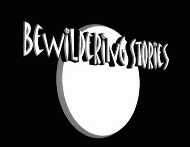Challenge 132
Scene Changes
- Moving from one setting to another is commonplace in fiction, and readers take it for granted. However, a writer — like a stage or film director — has to give the matter some thought. How much time — if any — elapses between one scene and the next? Who goes where, and with what baggage? What can be left out?
- In “Number of the End,” there is only one scene change. How does Jason Earls handle it?
- Battle Seer, chapter 10, part 1 is scenes within a scene. Julian Lawler uses a complex point of view where Renson sees the past through Andina’s dream. However, the dream sequence — which is actually a flashback — contains only one scene change: what is it?
- In Beverly Forehand’s “Country Matters,” movement from one scene to the next takes on an importance of its own. What happens in the process of moving from one “stage setting” to another?
- James Wasserman changes scenes at a — pardon the expression — madcap pace in “The Man Who Could Not Leave.” Do we need a map of the amnesiac’s apartment building? If not, why not? If so, how would it help?
- Katts and Dawgs, chapter 9, part 2 is very different from part 1. Roberto Sanhueza depicts Phydo, Thomm and Kitti in almost constant motion. Does that constitute a series of scene changes or is it a scene in itself? What effect does it have?
- Julian Lawler has asked for reader feedback on Battle Seer as it has unfolded so far. Ye Copy Editor feels that some initial chapters seem to be wasted without follow-up, especially the Prologue and chapter 4, “The Daemon of Light.” More importantly, perhaps, Palance Demondread seems to play the role of a “passive hero.” That is, he is something like a chess king: the most important piece on the board but limited in scope; he watches as the game’s opening unfolds in front of him.
Julian replied that the following chapters — call them the “middle game” — might have more reader interest in that regard. I have to say he’s right: the “Andina sequence” in chapters 9 and 10 (issues 129-132) well repays reading. It offers tensions galore, character development, psychology and action along with crucial glimpses of “backstory,” i.e. the history of the setting in which the characters move. Andina becomes a central figure and a potential force to be reckoned with.
Now for the bonus Challenge: Let’s all pitch in, readers, and reward Julian for being so open-minded. What do you think makes the difference between Andina’s and Palance’s stories? How do you think Julian’s approach to Andina’s story might reshape Palance’s story in the opening chapters?
Copyright © 2005 by Bewildering Stories
What is a Bewildering Stories Challenge?

